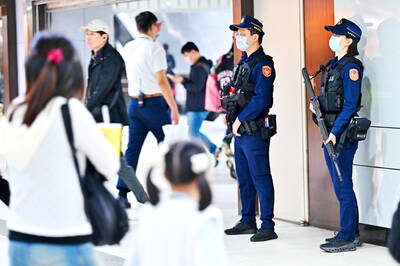US forces killed dozens of Iraqi fighters near Najaf overnight, hours after Washington issued an ultimatum to a radical cleric to clear his militia from mosques in the holy city.
Local television in Najaf said wounded people were dying for lack of blood supplies and issued an urgent appeal for donors.
The clashes were the deadliest since Moqtada al-Sadr and his Mehdi Army militia launched a brief revolt against the US-led occupation three weeks ago. They may mark a new phase in American efforts to dislodge him from Najaf, where he has taken refuge among some of the holiest shrines of Shiite Islam.
Forty-three militiamen were killed, a US official said. An AC-130 gunship -- a massive plane that spews cannon fire across wide areas -- destroyed an anti-aircraft system, she added.
Locals said aircraft had destroyed a militia checkpoint outside Kufa, 10km from Najaf, after a firefight. Staff at two nearby hospitals counted at least 23 dead and 34 wounded. Some of the casualties did not appear to be guerrillas.
As they prepared to bury the dead in the afternoon, local people said they were anxious about what might happen next.
Adding to the US burden, Spanish troops quit Najaf as part of a withdrawal decided by the new government in Madrid, where opposition to the occupation runs high. American troops have been forced to take their place.
In a second flashpoint, the Sunni Muslim town of Fallujah, local police took to the streets in force yesterday as a deadline expired for guerrillas to hand in heavy weapons.
The US Marines, who have besieged the town for three weeks, had said they would join police on patrols as early as yesterday. But they did not, and Iraqi police said there would be talks today on the joint patrols.
Hundreds of Iraqis have died in Fallujah, along with many Americans, in one of the bloodiest conflicts in a year.
Washington is struggling to douse these twin challenges to the new order in Baghdad without inflaming anger at civilian casualties before the US authority hands formal sovereignty back to an appointed Iraqi government on June 30.
Najaf and Fallujah have provided acid tests among Iraq's two main Muslim communities.
The long oppressed Shiite majority broadly welcomed the US invasion that overthrew Saddam Hussein, a Sunni. But impatience with disruption to daily life has angered many -- though support for Sadr's armed response has been mixed.
US Secretary of State Colin Powell said on Monday that US forces would have to maintain considerable powers after the handover, "which in some ways infringes on what some would call full sovereignty."
In Fallujah, US commanders say they face up to 2,000 fighters -- some diehard Saddam loyalists, others trying to reassert Sunni dominance of Iraq, and maybe about 200 foreign Islamic radicals, some possibly linked to al-Qaeda.
The Americans are in no hurry to spark an all-out confrontation in the town, 50km west of Baghdad, but hold out little hope the insurgents will surrender their arms.
Witnesses said US forces had fought guerrillas beside a highway north of Fallujah for around an hour early yesterday.
On Monday, Marines called in air strikes after skirmishes around a mosque left eight insurgents and a soldier dead.
Civilian casualties and the sight of refugees fleeing the city of 300,000 have dismayed many Iraqis. The US offensive began in response to the murder of four American contractors.
Also See Story:
Iraqi government must give troops free hand: Powell

TRAGEDY STRIKES TAIPEI: The suspect died after falling off a building after he threw smoke grenades into Taipei Main Station and went on a killing spree in Zhongshan A 27-year-old suspect allegedly threw smoke grenades in Taipei Main Station and then proceeded to Zhongshan MRT Station in a random killing spree that resulted in the death of the suspect and two other civilians, and seven injured, including one in critical condition, as of press time last night. The suspect, identified as a man surnamed Chang Wen (張文), allegedly began the attack at Taipei Main Station, the Taipei Fire Department said, adding that it received a report at 5:24pm that smoke grenades had been thrown in the station. One man in his 50s was rushed to hospital after a cardiac arrest

SAFETY FIRST: Double the number of police were deployed at the Taipei Marathon, while other cities released plans to bolster public event safety Authorities across Taiwan have stepped up security measures ahead of Christmas and New Year events, following a knife and smoke bomb attack in Taipei on Friday that left four people dead and 11 injured. In a bid to prevent potential copycat incidents, police deployments have been expanded for large gatherings, transport hubs, and other crowded public spaces, according to official statements from police and city authorities. Taipei Mayor Chiang Wan-an (蔣萬安) said the city has “comprehensively raised security readiness” in crowded areas, increased police deployments with armed officers, and intensified patrols during weekends and nighttime hours. For large-scale events, security checkpoints and explosives

PUBLIC SAFETY: The premier said that security would be tightened in transport hubs, while President Lai commended the public for their bravery The government is to deploy more police, including rapid response units, in crowded public areas to ensure a swift response to any threats, President William Lai (賴清德) said yesterday after a knife attack killed three people and injured 11 in Taipei the previous day. Lai made the remarks following a briefing by the National Police Agency on the progress of the investigation, saying that the attack underscored the importance of cooperation in public security between the central and local governments. The attack unfolded in the early evening on Friday around Taipei Main Station’s M7 exit and later near the Taipei MRT’s Zhongshan

ON ALERT: Taiwan’s partners would issue warnings if China attempted to use Interpol to target Taiwanese, and the global body has mechanisms to prevent it, an official said China has stationed two to four people specializing in Taiwan affairs at its embassies in several democratic countries to monitor and harass Taiwanese, actions that the host nations would not tolerate, National Security Bureau (NSB) Director-General Tsai Ming-yen (蔡明彥) said yesterday. Tsai made the comments at a meeting of the legislature’s Foreign Affairs and National Defense Committee, which asked him and Minister of National Defense Wellington Koo (顧立雄) to report on potential conflicts in the Taiwan Strait and military preparedness. Democratic Progressive Party (DPP) Legislator Michelle Lin (林楚茵) expressed concern that Beijing has posted personnel from China’s Taiwan Affairs Office to its